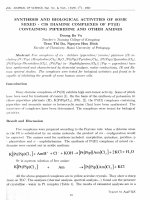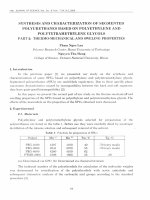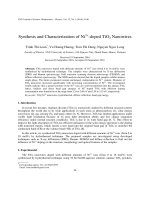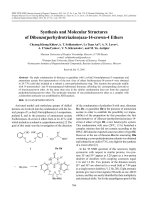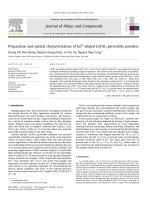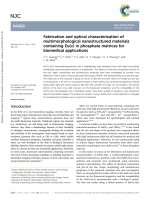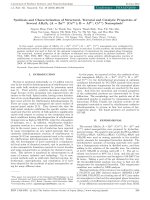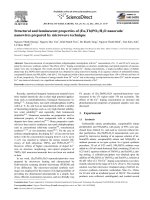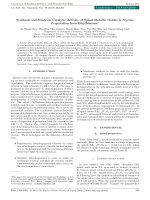DSpace at VNU: Synthesis and optical properties of ZnAl2O4:Cr 3+, Tb3+ powders
Bạn đang xem bản rút gọn của tài liệu. Xem và tải ngay bản đầy đủ của tài liệu tại đây (512 KB, 5 trang )
������������������������������������������������������������������������������������������������������������������������������������������������������������������������������������������������������������������������������������������������������������������������������������������������������������������������������������������������������������������������������������������������������������������������������������������������������������������������������������������������������������������������������������������������������������������������������������������������������������������������������������������������������������������������������������������������������������������������������������������������������������������������������������������������������������������������������������������������������������������������������������������������������������������������������������������������������������������������������������������������������������������������������������������������������������������������������������������������������������������������������������������������������������������������������������������������������������������������������������������������������������������������������������������������������������������������������������������������������������������������������������������������������������������������������������������������������������������������������������������������������������������������������������������������������������������������������������������������������������������������������������������������������������������������������������������������������������������������������������������������������������������������������������������������������������������������������������������������������������������������������������������������������������������������������������������������������������������������������������������������������������������������������������������������������������������������������������������������������������������������������������������������������������������������������������������������������������������������������������������������������������������������������������������������������������������������������������������������������������������������������������������������������������������������������������������������������������������������������������������������������������������������������������������������������������������������������������������������������������������������������������������������������������������������������������������������������������������������������������������������������������������������������������������������������������������������������������������������������������������������������������������������������������������������������������������������������������������������������������������������������������������������������������������������������������������������������������������������������������������������������������������������������������������������������������������������������������������������������������������������������������������������������������������������������������������������������������������������������������������������������������������������������������������������������������������������������������������������������������������������������������������������������������������������������������������������������������������������������������������������������������������������������������������������������������������������������������������������������������������������������������������������������������������������������������������������������������������������������������������������������������������������������������������������������������������������������������������������������������������������������������������������������������������������������������������������������������������������������������������������������������������������������������������������������������������������������������������������������������������������������������������������������������������������������������������������������������������������������������������������������������������������������������������������������������������������������������������������������������������������������������������������������������������������������������������������������������������������������������������������������������������������������������������������������������������������������������������������������������������������������������������������������������������������������������������������������������������������������������������������������������������������������������������������������������������������������������������������������������������������������������������������������������������������������������������������������������������������������������������������������������������������������������������������������������������������������������������������������������������������������������������������������������������������������������������������������������������������������������������������������������������������������������������������������������������������������������������������������������������������������������������������������������������������������������������������������������������������������������������������������������������������������������������������������������������������������������������������������������������������������������������������������������������������������������������������������������������������������������������������������������������������������������������������������������������������������������������������������������������������������������������������������������������������������������������������������������������������������������������������������������������������������������������������������������������������������������������������������������������������������������������������������������������������������������������������������������������������������������������������������������������������������������������������������������������������������������������������������������������������������������������������������������������������������������������������������������������������������������������������������������������������������������������������������������������������������������������������������������������������������������������������������������������������������������������������������������������������������������������������������������������������������������������������������������������������������������������������������������������������������������������������������������������������������������������������������������������������������������������������������������������������������������������������������������������������������������������������������������������������������������������������������������������������������������������������������������������������������������������������������������������������������������������������������������������������������������������������������������������������������������������������������������������������������������������������������������������������������������������������������������������������������������������������������������������������������������������������������������������������������������������������������������������������������������������������������������������������������������������������������������������������������������������������������������������������������������������������������������������������������������������������������������������������������������������������������������������������������������������������������������������������������������������������������������������������������������������������������������������������������������������������������������������������������������������������������������������������������������������������������������������������������������������������������������������������������������������������������������������������������������������������������������������������������������������������������������������������������������������������������������������������������������������������������������������������������������������������������������������������������������������������������������������������������������������������������������������������������������������������������������������������������������������������������������������������������������������������������������������������������������������������������������������������������������������������������������������������������������������������������������������������������������������������������������������������������������������������������������������������������������������������������������������������������������������������������������������������������������������������������������������������������������������������������������������������������������������������������������������������������������������������������������������������������������������������������������������������������������������������������������������������������������������������������������������������������������������������������������������������������������������������������������������������������������������������������������������������������������������������������������������������������������������������������������������������������������������������������������������������������������������������������������������������������������������������������������������������������������������������������������������������������������������������������������������������������������������������������������������������������������������������������������������������������������������������������������������������������������������������������������������������������������������������������������������������������������������������������������������������������������������������������������������������������������������������������������������������������������������������������������������������������������������������������������������������������������������������������������������������������������������������������������������������������������������������������������������������������������������������������������������������������������������������������������������������������������������������������������������������������������������������������������������������������������������������������������������������������������������������������������������������������������������������������������������������������������������������������������������������������������������������������������������������������������������������������������������������������������������������������������������������������������������������������������������������������������������������������������������������������������������������������������������������������������������������������������������������������������������������������������������������������������������������������������������������������������������������������������������������������������������������������������������������������������������������������������������������������������������������������������������������������������������������������������������������������������������������������������������������������������������������������������������������������������������������������������������������������������������������������������������������������������������������������������������������������������������������������������������������������������������������������������������������������������������������������������������������������������������������������������������������������������������������������������������������������������������������������������������������������������������������������������������������������������������������������������������������������������������������������������������������������������������������������������������������������������������������������������������������������������������������������������������������ spectra excited by 528 nm
wavelength of ZnAl2−x−y Tbx Cry O4 samples with various
x and y, annealed at 1100 ◦ C. It can be seen from Figure 8a that at the high Cr3+ concentrations (y = 0.050,
0.100) the intensity of the lines at 667, 675, 686, 698,
708 and 717 nm considerably reduces. Meanwhile, some
new lines at 707, 732 739 and 746 nm appear. After references [5–7], at the high Cr3+ concentrations the Cr3+ Cr3+ pairs are expected to form, and the line at 707 nm
is originated from the nearest Cr3+ -Cr3+ pairs. By examining PLE spectrum, the lines at the wavelengths of 732,
739 and 746 nm are believed to be the phonon-sidebands
of the line at 707 nm (the PLE spectra not shown here).
Figure 8b shows the PL spectra of ZnAl2−x−y Tbx Cry O4 samples, annealed at 1100 ◦ C, with y = 0.005 and
various x, excited by the wavelength of 528 nm. As seen
from the figure, with increasing the Tb3+ ion concentration up to x = 0.050, 0.100, the shape of the spectra does
not change, but their intensity is decreased. Therefore by
selecting the appropriate mole fractions x and y, we can
obtain the materials strongly emitting in both blue-green
and red regions.
10404-p4
T.T. Loan et al.: Synthesis and optical properties of ZnAl2 O4 :Cr3+ ,Tb3+ powders
4 Conclusion
(a)
The ZnAl2 O4 spinel powders co-doped with Tb3+ and
Cr3+ ions have been successfully synthesized by a solgel technique. The samples undergone heat-treatment at
1100 ◦ C exhibited the best crystallinity. The PL spectra of the samples showed two emission regions: the first
(blue-green) one was related to the emission of Tb3+ ions
and the second (red) one was related to the emission of
Cr3+ ions. By selecting the appropriate mole fractions
of the Tb3+ ions x and Cr3+ ions y, we can obtain the
materials strongly emitting in both blue-green and red
regions.
(b)
This work is financially supported by VNU University of
Science (Project No. NT-12-10) and Ministry of Science and
Technology of Vietnam (Project No. 103.02.51.09 from
NAFOSTED).
References
Fig. 8. The PL spectra excited by the wavelength of 528 nm
of the ZnAl2−x−y Tbx Cry O4 samples, heat-treated at 1100 ◦ C
(a) with x = 0.005 and different y, and (b) with different x and
y = 0.005.
1. M. Zawadzki, Solid State Sci. 8, 14 (2006)
2. X.Y. Chen, C. Ma, Opt. Materials 32, 415 (2010)
3. S. Menon, B. Dhabekar, E.A. Rajaa, S.P. More, T.K.G.
Rao, R.K. Kher, J. Lumin. 128, 1673 (2008)
4. D. Zhang, C. Wang, Y. Liu, Q. Shi, W. Wang, Y. Zhai, J.
Lumin. 132, 1529 (2012)
5. J. Derkosch, W.J. Mikenda, J. Lumin. 28, 431 (1983)
6. W. Mikenda, J. Lumin. 26, 85 (1981)
7. W. Nie, F.M. Michel-Calendini, C. Linares, G. Boulon, C.
Daul, J. Lumin. 46, 177 (1990)
10404-p5

